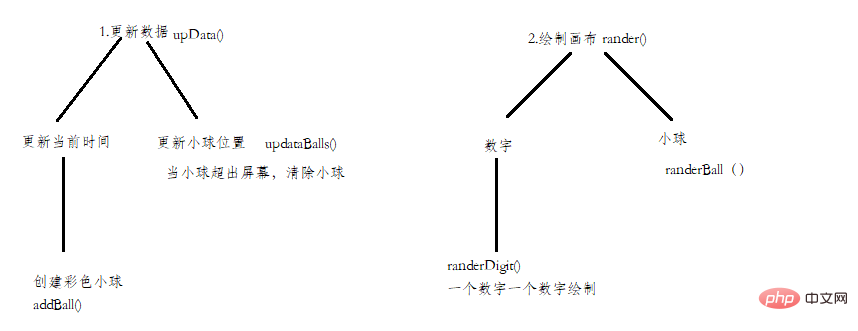
How to implement tangram pattern and particle clock effect on canvas? The following article will introduce it to you. It has certain reference value. Friends in need can refer to it. I hope it will be helpful to everyone.

canvas implements tangram
<canvas id="canvas" width="800" height="800"></canvas>
<script>
var rangram = [
{ p: [{ x: 0, y: 0 }, { x: 800, y: 0 }, { x: 400, y: 400 }], color: "#caff67" },
{ p: [{ x: 0, y: 0 }, { x: 400, y: 400 }, { x: 0, y: 800 }], color: "#67becf" },
{ p: [{ x: 800, y: 0 }, { x: 800, y: 400 }, { x: 600, y: 600 }, { x: 600, y: 200 }], color: "#ef3d61" },
{ p: [{ x: 600, y: 200 }, { x: 600, y: 600 }, { x: 400, y: 400 }], color: "#f9f51a" },
{ p: [{ x: 400, y: 400 }, { x: 600, y: 600 }, { x: 400, y: 800 }, { x: 200, y: 600 }], color: "#a594c0" },
{ p: [{ x: 200, y: 600 }, { x: 400, y: 800 }, { x: 0, y: 800 }], color: "#fa8ecc" },
{ p: [{ x: 800, y: 400 }, { x: 800, y: 800 }, { x: 400, y: 800 }], color: "#f6ca29" },
]
var canvas = document.getElementById('canvas');
if (canvas.getContext) {
var context = canvas.getContext("2d");
for(var i = 0; i < rangram.length; i++){
draw(rangram[i],context);
}
}
function draw(seat,context){
context.beginPath();
var pointArr = seat.p;
context.moveTo(pointArr[0].x, pointArr[0].y);
for(var i = 1; i < pointArr.length; i++){
context.lineTo(pointArr[i].x, pointArr[i].y);
}
context.closePath();
context.fillStyle=seat.color;
context.fill();
context.lineWidth=3;
context.stroke();
context.shadowColor='#ddd';
context.shadowBlur=30;
}
canvas implements particle clock

##
<canvas id="canvas"></canvas>
<script src="./digit.js"></script>
<script>
var SCREEN_WIDTH = document.body.clientWidth;
var SCREEN_HEIGHT = document.body.clientHeight;
var currentTime = null;
var MARGIN_LEFT = Math.round(SCREEN_WIDTH / 10);
var MARGIN_TOP = Math.round(SCREEN_HEIGHT / 10);
var RADIUS = Math.round(SCREEN_WIDTH * 4 / 5 / 108) - 1;
var timerArr = [];
var balls = [];
const colors = ["#33B5E5", "#0099CC", "#AA66CC", "#9933CC", "#99CC00", "#669900", "#FFBB33", "#FF8800", "#FF4444", "#CC0000"]
window.onload = function () {
var canvas = document.getElementById('canvas');
var context = canvas.getContext("2d");
canvas.width = SCREEN_WIDTH;
canvas.height = SCREEN_HEIGHT;
if (canvas.getContext) {
var context = canvas.getContext('2d');
setInterval(function () {
upData();
rander(context);
}, 50);
}
}
function upData() {
currentTime = new Date();
var curHours = currentTime.getHours();
var curMinutes = currentTime.getMinutes();
var curSeconds = currentTime.getSeconds();
var HoursOne = parseInt(curHours / 10);
var HoursTwo = parseInt(curHours % 10);
var MinutesOne = parseInt(curMinutes / 10);
var MinutesTwo = parseInt(curMinutes % 10);
var SecondsOne = parseInt(curSeconds / 10);
var SecondsTwo = parseInt(curSeconds % 10);
if (HoursOne != timerArr[0]) {
addBalls(MARGIN_LEFT + 0, MARGIN_TOP, HoursOne);
}
if (HoursTwo != timerArr[1]) {
addBalls(MARGIN_LEFT + 15 * (RADIUS + 1), MARGIN_TOP, HoursTwo);
}
if (MinutesOne != timerArr[2]) {
addBalls(MARGIN_LEFT + 39 * (RADIUS + 1), MARGIN_TOP, MinutesOne);
}
if (MinutesTwo != timerArr[3]) {
addBalls(MARGIN_LEFT + 54 * (RADIUS + 1), MARGIN_TOP, MinutesTwo);
}
if (SecondsOne != timerArr[4]) {
addBalls(MARGIN_LEFT + 78 * (RADIUS + 1), MARGIN_TOP, SecondsOne);
}
if (SecondsTwo != timerArr[5]) {
addBalls(MARGIN_LEFT + 93 * (RADIUS + 1), MARGIN_TOP, SecondsTwo);
}
timerArr = [HoursOne, HoursTwo, MinutesOne, MinutesTwo, SecondsOne, SecondsTwo];
updataBall();
}
function updataBall() {
for (var i = 0; i < balls.length; i++) {
balls[i].x = balls[i].x + balls[i].vx;
balls[i].vy = balls[i].vy + balls[i].g;
balls[i].y = balls[i].y + balls[i].vy;
if (balls[i].y + RADIUS > SCREEN_HEIGHT) {
balls[i].y = SCREEN_HEIGHT - RADIUS;
balls[i].vy = - balls[i].vy * 0.8;
}
}
var t = 0;
for (var i = 0; i < balls.length; i++) {
if (balls[i].x + RADIUS > 0 && balls[i].x - RADIUS < SCREEN_WIDTH) {
balls[t++] = balls[i];
}
}
while(balls.length > t){
balls.pop();
}
}
function addBalls(x, y, number) {
for (var i = 0; i < digit[number].length; i++)
for (var j = 0; j < digit[number][i].length; j++)
if (digit[number][i][j] == 1) {
var obj = {
x: x + j * 2 * (RADIUS + 1) + (RADIUS + 1),
y: y + i * 2 * (RADIUS + 1) + (RADIUS + 1),
g: 1.5 + Math.random(),
vx: Math.pow(-1, Math.ceil(Math.random() * 100)) * 4,
vy: -5,
color: colors[Math.floor(Math.random() * colors.length)]
}
balls.push(obj);
}
}
function rander(context) {
context.clearRect(0, 0, SCREEN_WIDTH, SCREEN_HEIGHT);
var hours = currentTime.getHours();
var minutes = currentTime.getMinutes();
var seconds = currentTime.getSeconds();
renderDigit(MARGIN_LEFT, MARGIN_TOP, parseInt(hours / 10), context)
renderDigit(MARGIN_LEFT + 15 * (RADIUS + 1), MARGIN_TOP, parseInt(hours % 10), context)
renderDigit(MARGIN_LEFT + 30 * (RADIUS + 1), MARGIN_TOP, 10, context)
renderDigit(MARGIN_LEFT + 39 * (RADIUS + 1), MARGIN_TOP, parseInt(minutes / 10), context);
renderDigit(MARGIN_LEFT + 54 * (RADIUS + 1), MARGIN_TOP, parseInt(minutes % 10), context);
renderDigit(MARGIN_LEFT + 69 * (RADIUS + 1), MARGIN_TOP, 10, context);
renderDigit(MARGIN_LEFT + 78 * (RADIUS + 1), MARGIN_TOP, parseInt(seconds / 10), context);
renderDigit(MARGIN_LEFT + 93 * (RADIUS + 1), MARGIN_TOP, parseInt(seconds % 10), context);
randerBall(context);
}
function randerBall(context) {
for (var i = 0; i < balls.length; i++) {
context.fillStyle = balls[i].color;
context.beginPath();
context.arc(balls[i].x, balls[i].y, RADIUS, 0, Math.PI * 2, 0);
context.closePath();
context.fill();
}
}
function renderDigit(x, y, number, context) {
context.fillStyle = 'rgb(0,102,153)';
for (var i = 0; i < digit[number].length; i++)
for (var j = 0; j < digit[number][i].length; j++)
if (digit[number][i][j] == 1) {
context.beginPath();
context.arc(x + j * 2 * (RADIUS + 1) + (RADIUS + 1), y + i * 2 * (RADIUS + 1) + (RADIUS + 1), RADIUS, 0, 2 * Math.PI)
context.closePath();
context.fill()
}
}
</script>digit = [ [ [0,0,1,1,1,0,0], [0,1,1,0,1,1,0], [1,1,0,0,0,1,1], [1,1,0,0,0,1,1], [1,1,0,0,0,1,1], [1,1,0,0,0,1,1], [1,1,0,0,0,1,1], [1,1,0,0,0,1,1], [0,1,1,0,1,1,0], [0,0,1,1,1,0,0] ],//0 [ [0,0,0,1,1,0,0], [0,1,1,1,1,0,0], [0,0,0,1,1,0,0], [0,0,0,1,1,0,0], [0,0,0,1,1,0,0], [0,0,0,1,1,0,0], [0,0,0,1,1,0,0], [0,0,0,1,1,0,0], [0,0,0,1,1,0,0], [1,1,1,1,1,1,1] ],//1 ......
javascript special effects column! !
The above is the detailed content of How to implement tangram pattern and particle clock effect on canvas? (code example). For more information, please follow other related articles on the PHP Chinese website!